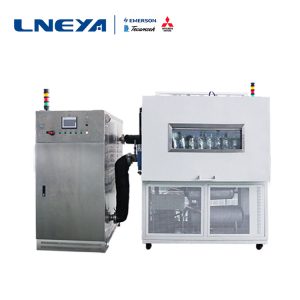Introduction of distillation principle and temperature cycle control device
Distillation is a common method for purifying liquid substances and separating mixtures. The boiling point of the compound can also be measured by distillation, so it also has a certain significance for the identification of pure liquid organic compounds.
The change of saturated vapor pressure of a substance at different temperatures is the basis of distillation separation. Heating the liquid to boiling makes the liquid into a vapor, and then the vapor is cooled and then condensed into a liquid. The combined operation of these two processes is called distillation.
The boiling points of the components of the liquid mixture must be very different, at least above 30 ° C to achieve a better separation effect. Select the heating device according to the boiling point of the distilled liquid. When the boiling point of the distilled liquid is below 80oC, use a hot water bath to heat; when the boiling point of the liquid is above 100 ° C, use a simple air bath or an oil bath to heat the asbestos mesh When the temperature is above 200 ° C, use a sand bath, an air bath and an electric heating mantle.
In the distillation operation, the following points should be noted:
(1) Control the heating temperature. If a heating bath is used, the temperature of the heating bath should be several degrees higher than the boiling point of the distilled liquid, otherwise it will be difficult to distill the distillate. The more the heating bath temperature is higher than the boiling point of the distilled liquid, the faster the distillation speed. However, the temperature of the heating bath should not be too high, otherwise it will cause the vapor pressure of the distillation flask and the upper part of the condenser to exceed atmospheric pressure, which may cause accidents, especially when distilling low-boiling substances.
The temperature should be strictly controlled during distillation because things that are too low can not be steamed out, and those that are too high can be steamed out, and may also cause the decomposition of the required substances, or the decomposition of undesired substances to generate new impurities! Prolonging the time can make the distillation process more adequate.
LNEYA dynamic temperature control system SUNDI series temperature range is -120 ℃ to 350 ℃, superior performance, high precision, intelligent temperature control. Fully enclosed system, extending the thermal conductivity of the liquid, a very wide temperature range, without changing the liquid medium. The ultra-high temperature cooling technology can directly cool from the high temperature of 300 degrees. The temperature difference between the jacket oil and the raw material process can be set separately to control the process temperature and jacket temperature separately.

|
Related recommendations
-
Ultra-low temperature refrigeration circulator condenser maintenance instructions
2019Maintenance is an important task for users of ultra-low temperature refrigeration circulators. Wuxi Guanya LNEYA reminds that the maintenance of the condenser is a relatively important task in its maintenance work. So what should be paid attention...
View details -
Celebrate New Year’s Day and Welcome New Year
2000When the bells echo in the clear night sky,When the calendar turns to a new page,We are about to usher in a new year.Thanks for this year's harvestLet us have precious experience on our growthThere is always a reward for sweatThis yearWe sh...
View details -
Maintenance of Glycol Cooling Heating Control System
2813Apart from the attention needed during the daily use, the regular check and maintenance of Glycol Cooling Heating Control System are also very important. In order to help all of you learn to use Glycol cooling heating more efficiently, LNEYA Ref...
View details -
What Are The Characteristics Of The Reactor Heating System?
1233Wuxi Guanya LNEYA reactor heating system The liquid circulation of the whole system is closed, the system has an expansion vessel, the expansion vessel and the liquid circulation are adiabatic, do not participate in the liquid circulation, only th...
View details
 LNEYA Industrial Chillers Manufacturer Supplier
LNEYA Industrial Chillers Manufacturer Supplier














